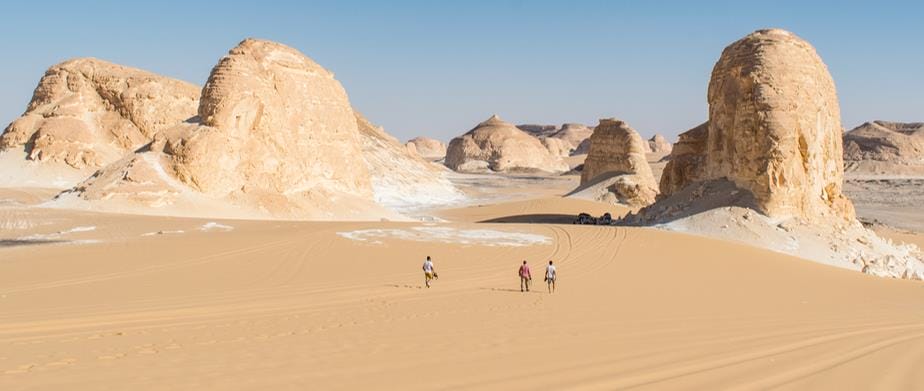Wadi al Rayan Protectorate
This UNESCO World Heritage Site, located just west of Fayoum, includes two lakes, sulfur springs, two mountains, golden sand dunes, and the only waterfalls in Egypt. Climb up to the top of Al-Modawara Mountain (Gabal al-Modawara) to take in the beauty of this protectorate. Views from the top include the nearby lakes and dunes, and it’s also a great place to spot some rare eagles or falcons. Magic Lake, which lies inside the protectorate, is one of the most beautiful desert landscapes in the Western Desert, and its surrounding sand dunes are a perfect spot for sandboarding. While traveling through Wadi al Rayan Protectorate, you won’t want to miss the prehistoric whale fossils of Wadi al Hitan. Many endangered animals call Wadi al Rayan home, including white deer, Egyptian deer, sand fox, wolves, and rare migrating birds.
Lake Qarun Protectorate
First recorded in 3,000 BC, this ancient lake used to be a large freshwater lake known as Moeris. The archeological sites surrounding the lake, such as the Old Kingdom Basalt Quarry, Qasr al Sagha Temple, Dimeh Archeological City, and Abu Leif Monastery, can keep you busy exploring for days. The magnitude of Lake Qarun’s cultural, historical, and scientific value is equaled by its natural heritage. Known as the birdwatcher’s paradise, Lake Qarun is home to nearly half of Egypt’s hundreds of bird species. You’ll be able to spot both flamingos and white pelicans here.
Sannur Cave Protectorate
At 40 million years old, Sannur Cave is considered to be one of the oldest caves in the world. Millions of years ago, percolating water filtered down through limestone and created geological features of stalagmites, stalactites, curtains, and columns. What was also created in this process was alabaster, which is why this area was a quarry site for pharaonic stonemasons. It has been declared a protected area for its geological and historic significance.
The White Desert Protectorate
This unique area has dunes, domes, and wind-carved chalk sculptures, making one of the most unforgettable desert landscapes in Egypt. Originating as an ancient seabed, this natural art gallery has been in the making for 30 million years! One-of-a-kind sculptures resembling mushrooms are locally referred to as “desert ice”. Inside the layers of limestone, you can easily spot marine fossils, such as sea urchins, mollusks, crustaceans, and coral reef. In contrast to the white carpet desert floor are the black hematite stones, some of which look like flowers or stars. Some animals that call this place home are the fennec fox, the Saharan horned viper, the sooty falcon, Egyptian gazelles, rams, and several types of reptiles.
Al Wahat al Bahariyya Protectorate
The area surrounding the Bahariyya Oasis showcases incredible sites that are home to desert wildlife, including the rare Egyptian wolf, sand foxes, and Dorca gazelles. Birds flocking to this oasis sanctuary include the Egyptian barn swallow, black and mourning wheatears, little stints, and the always magnificent white-throated kingfisher. In addition to its cultural and archeological sites, such as the Valley of the Golden Mummies and a 5th century Coptic church, Al Wahat al Bahariyya has a rich geological heritage. The Black Desert, formed by volcanic activity, is also located within this protected area, and the fossils from the world’s second largest dinosaur can be seen here!
Mount Kamel Meteor Protectorate
This is the site where an iron meteorite crashed into the earth’s surface 5,000 years ago in the southwest corner of Egypt. The 45-m-wide crater filled with sand was only recently discovered and excavated. The largest fragment unearthed weighs 83 kg and is currently displayed in the Egyptian Geological Museum in Cairo.
Al Gilf al Kebeer
One of the most remote protected areas in Egypt, Al Gilf al Kebeer Plateau, is where the events of the film The English Patient took place. The site holds thousands of traces of Paleolithic and Neolithic human history. What we understand from these traces of ancient life is that hunter-gatherers and pastoral communities lived side-by-side in a golden age for flora and fauna. From the remains of rock tools to rock carvings and paintings, to caves that housed these early humans, Al Gilf al Kebeer is a sprawling open window to human life at a time when the Western Desert was made up of freshwater lakes and greenery.


